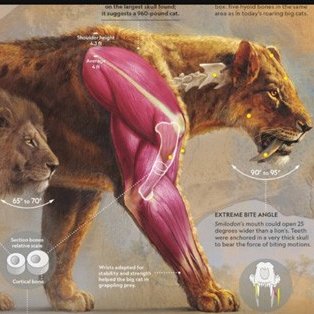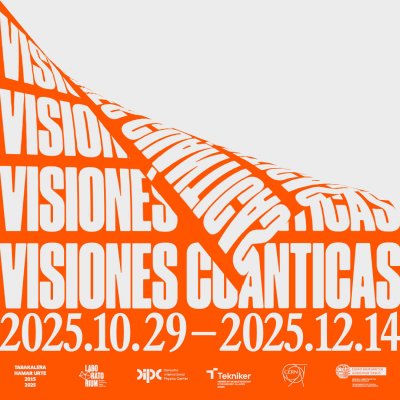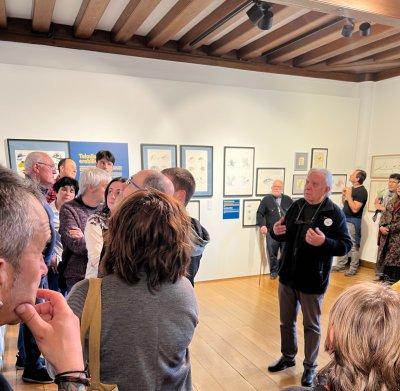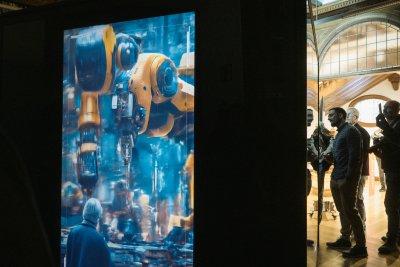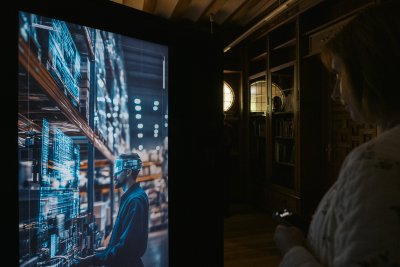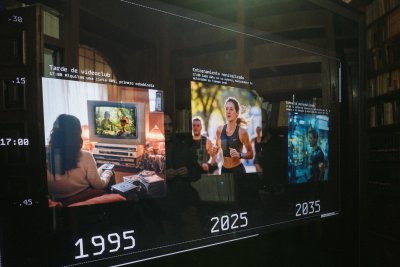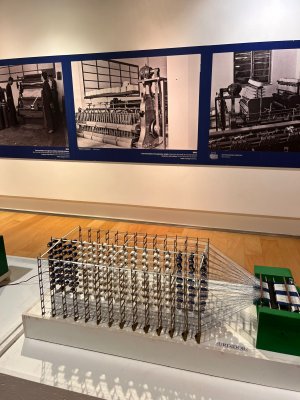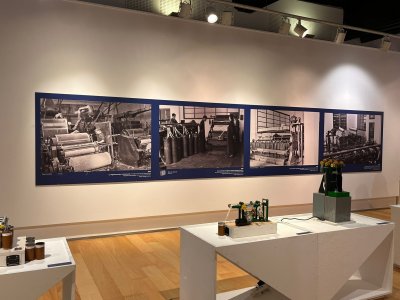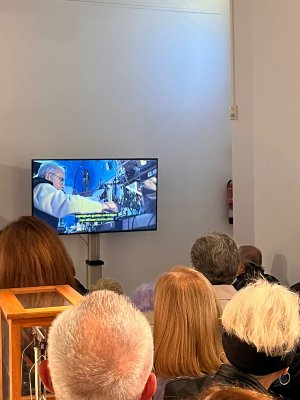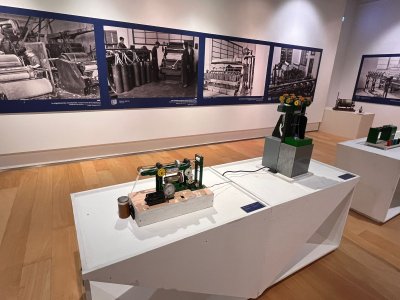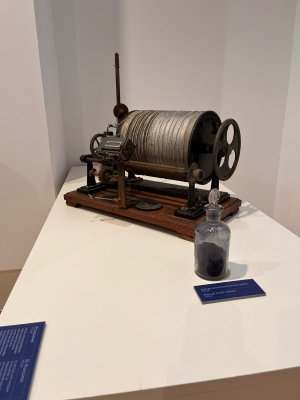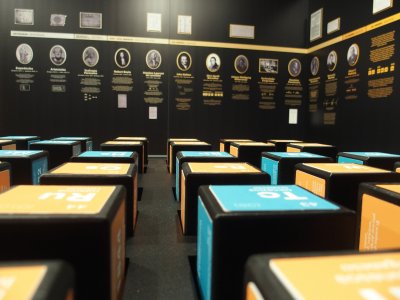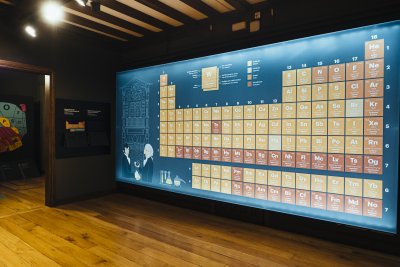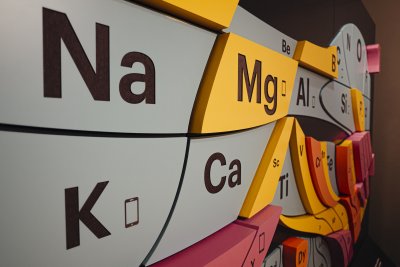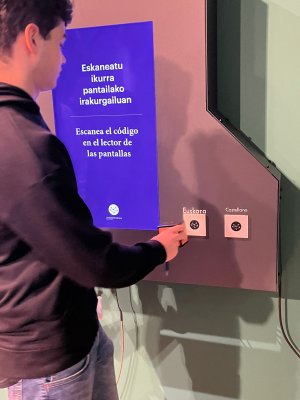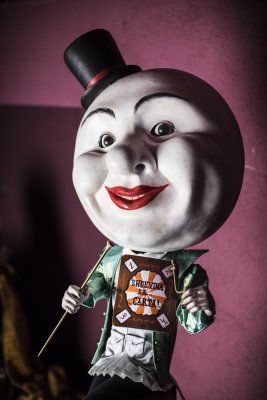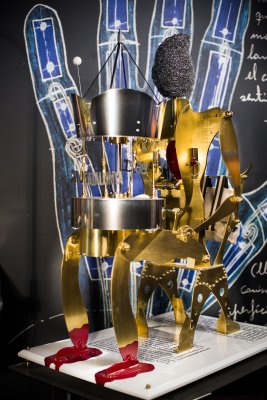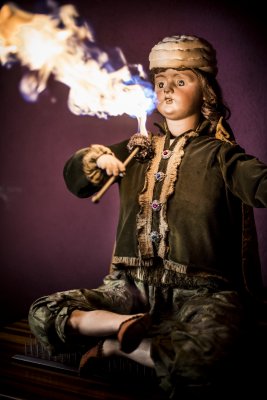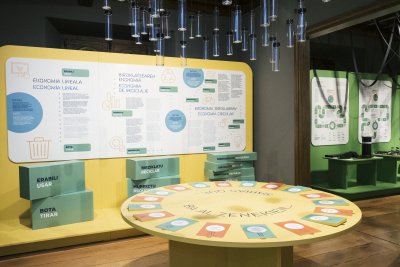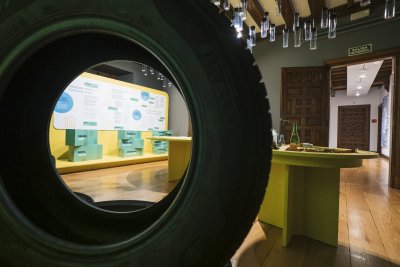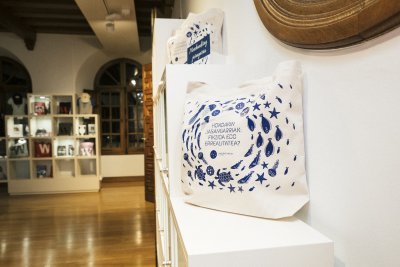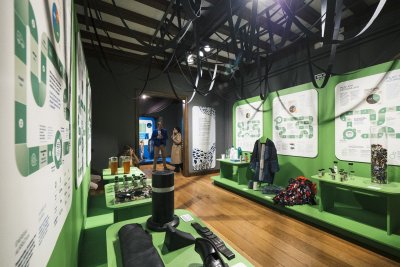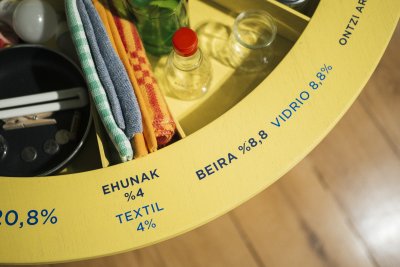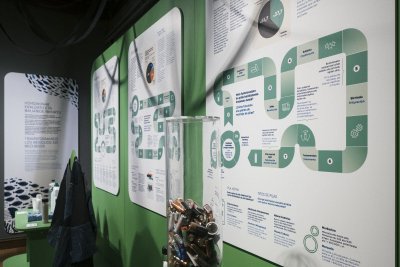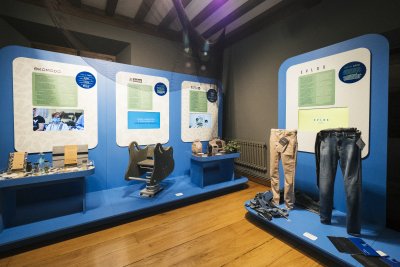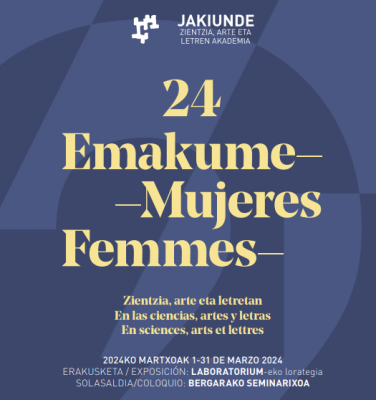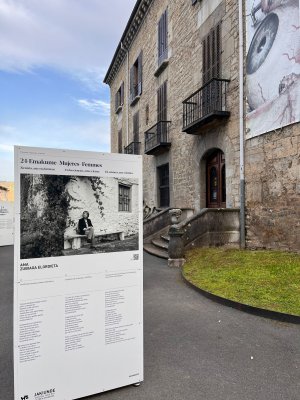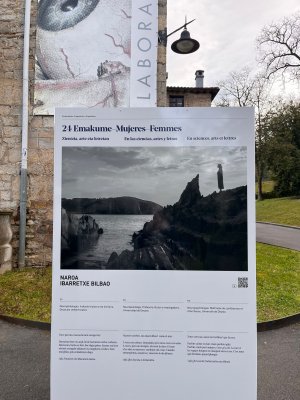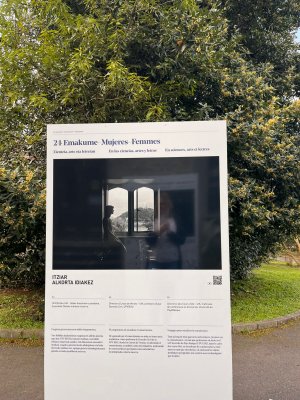Temporary exhibitions
"Infografia Zientifikoaren Esploratzailea" Aroztegi Aretoan
Erakusketa
Fernando Baptista, zientzia-ilustrazioaren nazioarteko erreferentea, Bergarara iritsiko da bere lan zoragarrien erakusketarekin. Bere marrazki eta konposizioek anatomia, geografia eta historia bezalako gaiak bistaratzen dituzte, irudiaren bidez ezagutza transmitituz. Bisitariak ikusiko du nola datuak eta artea uztartuz, informazioa esperientzia bisual bihurtzen den. Erakusketa honek ondare grafiko eta hezitzaile bat eraikitzen du, gaur egungo gizartearentzat zein etorkizuneko belaunaldientzat baliagarri izango dena: ulermena, estetika eta irudimena uztartzen dituen ezagutza.
"Visiones cuánticas" (Ikuspegi kuantikoak)
Erakusketa
Sei pantaila didaktiko eta ikus-entzunezkoen bidez, fisika kuantikoa publiko orokorrera hurbiltzen duen esperientzia interaktiboa.
Hitzik gabe dibulgatzea
Erakusketa
Laboratorium Museoan urriaren 19ra arte ikusgai egongo den ‘Hitzik gabe dibulgatzea’ erakusketak, ilustratzaile zientifikoaren azken 40 urteetako jardunean barneratzen du bisitaria. Ibilaldi lasaia da, xehetasunez beteta egon arren. Bertan, marrazkiak egiteko Carles Pucheren teknikak erakusten dira, eta baita paisaia edo ikerketako marrazki zientifikoen, antropologikoen, zoologikoen edo botanikoen irudikapena.
THE BLACK BOX
Erakusketa
Laboratorium Museoak THE BLACK BOX modulu berria inauguratu du azaroaren 5ean, adimen artifizialaren (AA) mundura hurbiltzeko esperientzia interaktibo eta hezigarria eskaintzen duena. Kuboa lau alde ditu, eta alde bakoitzak bizitzaren dimentsio garrantzitsu bat jorratzen du: eguneroko bizitza, industria, gizartea eta etika. Moduluaren bidez, bisitariek adimen artifizialaren eragina eta etorkizuna azter dezakete, lau ikuspegitatik.
Adimen artifiziala eguneroko bizitzan gero eta presentzia handiagoa duen teknologiaren alorra da, eta garrantzitsua da gure ikusleek horri buruzko ikuspegi zabala eta kritikoa izan dezaten.
THE BLACK BOX kuboak bisitariei adimen artifizialaren funtzionamendua modu interaktiboan ulertzeko aukera eskaintzen die, eta lau aldeen bidez kontzeptu eta errealitate desberdinak jorratzen ditu. Lehenengo aldeak eguneroko bizitzaren dimentsioa aztertzen du, eta horrelako teknologiek nola eragiten duten gure eguneroko jardueren kudeaketan erakusten du. Bigarren aldean, industria sektorea lantzen da, adimen artifizialak nola eraldatzen duen produkzio eta lan munduaren ikuspegi bat eskainiz.
Gizartearen ikuspegitik, hirugarren aldeak teknologia honen eragina gizartean eta harremanetan jorratzen du, eta azkenik, etika aldetik, teknologiaren erabileraren inguruko galderak eta dilema etikoak planteatzen ditu, adimen artifiziala nola aplikatu eta kontrolatu behar den gizarte arloan.
THE BLACK BOX moduluaren bidez, bisitariek adimen artifizialaren etorkizunean izan ditzaketen galderak eta zalantzak aztertzeko aukera izango dute. Laboratorium Museoa, jakintza eta berrikuntza bultzatzeko bere ahaleginean, gizarteari teknologia aurreratuen eta etika arloko hausnarketa horren inguruko ikuspegi zabala eskaintzen jarraitzen du.
Ez galdu aukera eta etorri THE BLACK BOX ezagutzera!
Ehungintza prozesua: Joxe Mari Rubio eta Felipe Uriarteren eskutik
Erakusketa
Bergara herri handi eta oparoa izan da. 1783an, Elhuyar anaiek mugarri erabakigarri bat lortu zuten, wolframa hemen isolatu baitzuten. Horrela, Bergararen izena idatzi zuten zientziaren urtekarietan.
Hala ere, Bergarako historia ez da soilik klabe zientifikoan eratzen; tinta urdinez ere idazten da. Bi mende baino gehiagoz, ehungintza izan zen bere ekonomia eta gizartearen motorra, herri honen nortasuna moldatuz.
Gaur egun, Jose Mari Rubiok eta Felipe Uriartek sortutako maketek garai hura berpizteko aukera ematen digute, Bergarako memoria kolektiboan bizirik dirauen ondarea, alegia.
Makineriaz gain, Algodonerako eta Elementaleko irudiak, laborategiko tresnak, katalogoak eta zigiluak ere aurkituko dira bertan. Era berean, ikus-entzunezko proiekzio bat eskainiko da, non ehungintzaren historia kontatzen den eta bi egileek makinen sorkuntza prozesua azaltzen duten.
Urriaren 25ean izan zen inaugurazioa eta azaroaren 10a arte izango da ikusgai Aroztegi aretoan.
- Astearteetik ostiralera: 18:00 - 20:30
- Larunbatetan: 12:00 - 14:00 eta 18:00 - 20:30
- Igandetan: 12:00 - 14:00
Ez galdu aukera Bergarako industriaren historia gertuagotik ezagutzeko!
Taula periodikoa 2025: unibertsoa osatzen duten elementuak
Erakusketa
2019/2020an, museoak anbizio handiko erakusketa egin zuen Taula Periodikoari buruz, asmakuntzaren urteurrenarekin batera. Erakusketa horretan, bisitariek gure mundua osatzen duten osagai kimikoak eta horien antolaketa ezagutu dezakete, elementu kimikoek gizakiarekin eta naturarekin daukaten harremana ikasten dute, eta kimikarien aurkikuntzen historiaz jabetu daitezke ere.
Aurten erakusketa hori berreskuratu dugu, eta, aipatutakoaz gain, panelei eta jolas didaktikoei esker, Dimitri Ivanovich Mendeleiev zientzialari errusiarrak, 1869an, gaur egun erabiltzen dugun taula periodikoa sortu zuela gogoratuko dugu. Taula Periodikoaren asmakuntzak izan duen garrantzia azpimarratzen dugu, eta, aldi berean, Elhuyar anaiak omentzen ditugu, 1783an Wolframa isolatu baitzuten, 1778an Real Seminario Patriótico Bascongadoko elkarteak Bergaran sortutako Laboratorium Chemicum-ean.
1. Aretoa: Taula periodikoaren bilakaera
Taula periodikoaren sorrera zientziaren historiako jazoera adierazgarrietako bat da. Lehendabiziko aretoan taula periodikoa dago erakusgai modu interaktiboan. Hala, haren funtzioa eta haren bilakaera azaltzen dira egun duen konfiguraziora iritsi arte. Gainera, hura osatzen duten elementu kimiko bakoitzaren ezaugarriak ageri dira.
2. Aretoa: Wolframaren aurkikuntza eta Elhuyar anaiak
Ikerketa zientifikoak gertaera, datu, erlazio edo lege berriak ematea proposatzen du. Bergaran Elhuyar anaiek wolframioa isolatzea lortu zuten 1783. urtean metodo zientifiko bat erabiliz. Bigarren eremu honetan wolframioaren aurkikuntza eta Bergarak aurkikuntza horretan izandako garrantzia jorratzen dira.
3. Aretoa: Oparotasunaren taula
Azken areto honetan ezagutuko dugu Kimikako Europako Elkarteak (EuChemS) sortu eta Europako Parlamentuan 2019an aurkeztutako Oparotasunaren Taula. Taula periodiko horretan elementu kimiko naturalak jasotzen dira eta horietako bakoitza Lurrean oparoa ala urria den islatzen da. Oparotasunaren taula lagungarri izango zaigu zein baliabide babestu behar ditugun ulertzeko, izan ere, datozen urteetan horien hornidura arrisku larrian dago.
Automatak: mekanismo magikoak
Erakusketa
Uztailaren 1etik urriaren 11arte, ingeniaritzaren eta giza sormenaren bihotzera egindako bidaia liluragarri batera "Automatak: mekanismo magikoak" erakusketarekin gonbidatzen zaituzte Laboratorium Museoak. Erakusketa honek gaur egungo roboten aurrekoen sekretuak azaltzen dituzten hamabi pieza eder aurkezten ditu. Automata bakoitza, espeka-sistema, pinoi, palanka eta engranaje-sistema konplexu eta xelebreek animatua, ingeniaritzaren maisulan bat da, magia eta mekanika elkarlotzen ziren garaira garamatzana.
XIX. mendearen erdialdetik XX. mendera arte, Erdialdeko Europako erloju-maisuek izaki mekaniko horiek sortu zituzten ikusleak txunditu eta entretenitzeko. Garai batean elitearen entretenimendua izan ziren mirari horiek, gaur egun mugimendu zehatz eta xarmagarriei bizia eman zieten artisau-trebetasuna eta asmamena berraurkitzera gonbidatzen gaituzte. Bilduma honetako pieza bakoitza giza asmamenaren eta jakin-mina sortzeko eta eguneroko monotoniatik ihes egiteko nahiaren testigantza da.
Lagun gaitzazu eta ikus ezazu mekanika eta artea nola elkartzen diren engranaje eta palanka dantza batean, mugimendu bakoitzaren atzean ezkutatutako magia azaleratuz. Ezagutu ezazu automaten mundu harrigarria eta disfrutatu teknologiaren aitzindari hauek!
Bisita gidatuak aurrez aurretik erreserbatuta.
Iraunkortasunari hamaika begirada
Erakusketa
Maiatzaren 27tik 31arte Iraunkortasunari hamaika begirada erakusketa ibiltaria izango da Laboratorium museoan.
Debagoiena 2030 ekimenak, Debagoieneko Mankomunitatearekin eta eskualdeko udalekin elkarlanean klima larrialdiaz eta energia trantsizioaz hausnarketa egiteko jardunaldia antolatu du. Helburua da Klima Larrialdiak Debagoienean izango duen inpaktua ezagutzea, arlo eta ikuspegi desberdinak elkarjosiz.
Jardunaldi nagusia maiatzaren 24an egingo da, Arrasateko Kulturateko klaustroan eta bertan, eremu desberdinetako adituak eta arituak izango dira, Debagoieneko errealitatearen berri ikuspegi desberdinetatik emateko eta datozkigun erronken gainean aritzeko.
Tokiko administrazioa energia trantsizioaren aurrean Jardunaldi nagusiaz gain, eskualdeko administrazio publikoak egun bizi dugun erronka konplexuen garaian bete beharreko rolaren gainean hausnartzeko espazioa ere sortu gura izan du Debagoiena 2030 ekimenak, fokua ipiniaz energia trantsizioaren alorrean.
Erakusketan bertan, maiatzaren 29an, Goienerren eskutik, energia fakturen inguruko azterketa egiteko aukera eskainiko da.
Erakusketaren bisita gidatua eskainiko da ere maiatzaren 30ean, 18:00etan. (Bisitan parte hartzeko izena ematea gomendatzen da).
Hondakin jasangarriak: fikzioa edo errealitatea?
Erakusketa
Martxoaren 28an zabalduko da 'Hondakin jasangarriak: fikzioa edo errealitatea?' erakusketa, eta ekainaren 16ra arte aldi baterako erakusketen gunean egongo da.
Seinale askok uzten dute agerian gure bizimodua dagoeneko ez dela jasangarria: klima-aldaketa, kutsadura-tasak, baliabideen gehiegizko ustiapena, ur-eskasia... Hortaz, guztiok lehenbailehen hartu behar dugu geure gain eredu berri baterako trantsizioar birziklatzean, berrerabiltzean, konpontzean eta berreskuratzean oinarritutako eredu baterako trantsizioa erronka eta betebeharra da guretzat.
Birziklatutako eta berrerabilitako etxeko hondakinetan zehar egindako sarrera-bidaia gisa planteatu da erakusketa hau, erakutsi nahi baitu posible dela ingurune naturala errespetatzen duen ekoizpeneta kontsumo-eredu alternat¡bo batera aldatzea.
Berreskuratzeaz, berritzeaz eta konpontzeaz hitz egiten du erakusketak, ideia bakoitza areto batean landuta.
BERRESKURATU - BIRDISEINATU - BERRITU - KONPONDU - BERRERABILI - MURRIZTU - BIRZIKLATU
1. ARETOA
Aretoan proposatutako ibilbidean, Industria iraultzaz geroztik gizakiok oro har erabili ditugun hiru ekoizpen-sistemak ikusiko ditugu: ekoizpen linealeko sistema, birziklapena eta ekonomia zirkularra.
Aurkezpen horretan, sistema horien arteko desberdintasunak ulertzeko o¡narrizko gakoak aurkituko ditugu, hain zuzen ere manipulazio-jokoen bidez, eskema grafikoen bidez eta Ellen MacArthur Fundazioak utzitako ikus-entzunezko baten bidez.
2. ARETOA
Bigarren aretoan, prozesu eta estrategia desberdinak erabiliz birziklatu eta berrerabil daitezkeen 6 hondakin-mota aurkezten dira. Hemen, ikasiko dugu pneumatiko zahar batek, jaka hautsi batek edo egunero janaria prestatu ondoren geratzen zaigun olio erabiliak beste bizi-ziklo bat izan dezaketela, beste produktu batzuk fabrikatzeko lehengai gisa. Hondakinen ahalmena izugarria da!
3. ARETOA
Erakusketako azken aretoan, Euskadin izandako kasu arrakastatsu batzuk ezagutuko ditugu. Enpresa-ekimenei buruz ari gara. Batzuk oso gazteak eta berriak dira, eta beste batzuek, berriz, mende eta erditik gorako historia dute, eta gai izan dira birziklapenean eta ekonomian bide emankorra aurkitzeko, garapen ekonomikoa eta jasangarritasuna bateragarri egiten dituzten etorkizuneko proposamenak garatu ahal izateko.
24 emakume zientzia, arte eta letretan
Erakusketa
Egungo erronketako bat da emakumeek jakintzaren arloetan egiten duten lana ikusezin bihurtzen duten gizarte-ohiturak gainditzea.
Neska-mutilek edozein diziplinatan aukera-berdintasunean ikasi eta lan egin dezaten, gure gizarteak emakumeek bizitzako arlo guztietan duten presentzia ezagutu eta ikusarazi behar du. Emakumeak ari dira zientzietan, arteetan eta letretan, eta egiten duten lanarekin gozatzen dute.
24 Emakume zientzia, arte eta letretan erakusketaren helburua da gizarteari errealitate hori erakustea, eta etorkizuneko belaunaldiak inspiratzea.
Erakusketan aurkezten diren emakumezko jakitunek, ibilbide profesional luzea egin eta gero, bikaintasuna lortu dute beren diziplinetan, eta, beste emakumezko jakitun gazteago batzuk punta-puntako lana egiten ari dira beren lanbideetan.
Erakusketako 24 kideen argazkiak eta bideoak Marina Palaciok eginak dira eta Jakiunderen 2022 eta 2023ko egutegian dute jatorria.
Jakiunde jakintzaren eta esperientziaren topaleku da, eta arlo ezberdinetako aditu diren kideen talentua eta hausnarketarako ahalmena gizartearen eskura jartzea du helburu. Zientziak, Arteak eta Letrak lantzeko eta sustatzeko jarduerak antolatzen ditu Akademiak. Jakintza eta zorroztasun zientifikoa gizartearen esku jarriz, haren eragile aktibo izan nahi du, egungo arazoei eta erronkei irtenbideak bilatzen lagunduz. Egungo erronketako bat da emakumeek jakintzaren arloetan egiten duten lana ikusezin bihurtzen duten gizarte-ohiturak gainditzea. Neska-mutilek edozein diziplinatan aukera berdintasunean ikasi eta lan egin dezaten, gure gizarteak emakumeek bizitzako arlo guztietan duten presentzia ezagutu eta ikusarazi behar du. Emakumeak ari dira zientzietan, arteetan eta letretan, eta egiten duten lanarekin gozatzen dute. 24 Emakume zientzian, artean eta letretan ekimenaren helburua da gizarteari errealitate hori erakustea eta etorkizuneko belaunaldiak inspiratzea. Koaderno honetan aurkezten diren hainbat emakumezko jakitunek ibilbide profesional luzea egin eta gero bikaintasuna lortu dute beren diziplinetan, eta beste emakumezko jakitun gazteago batzuk punta- puntako lana egiten ari dira beren lanbideetan.


